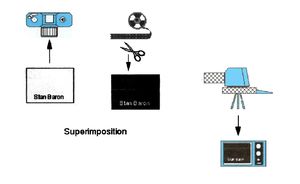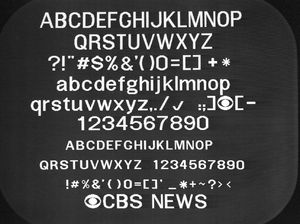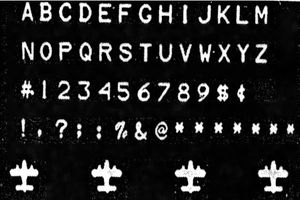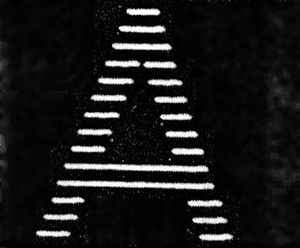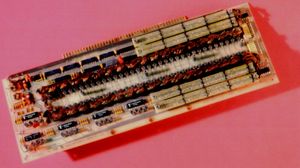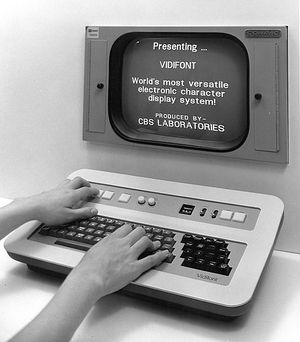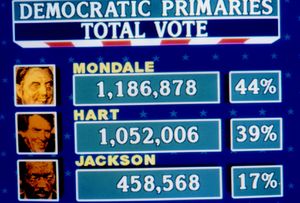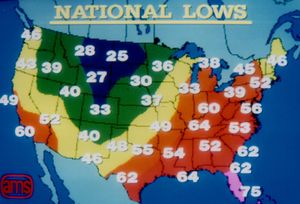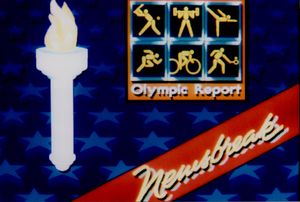First-Hand:Inventing the Vidifont: the first electronics graphics machine used in television production
Contributed By: Stanley Baron, IEEE Life Fellow
Inventing the Vidifont:
In 1966, Rudi Bass, Director of Graphics Arts for CBS News, was tackling a set of challenges in preparation for the 1968 elections. Among other tasks, the Graphics Arts Department was required to generate graphics, including title graphics, for the Republican and Democratic National Conventions. In order to comprehend the magnitude of the task they faced, it is helpful to understand how television graphics were created in those times.
Graphics, including all title graphics (i.e. "President Lyndon B. Johnson” or "Walter Cronkite”) were set in type or drawn by graphic artists. The graphic was photographed using 35-mm film, the film developed, and a 35-mm slide generated. The time to generate a slide exceeded one hour. The slide, when used, was placed in a special projector, scanned by a television camera, and keyed into the studio video feed. This method was known as ‘Superimposition’.
Since the news department had to be prepared to identify any speaker who might appear before the cameras during the convention, Bass was faced with creating in excess of 4000 slides in advance for each convention. If an individual who was not a delegate or an alternate was called upon to give a seconding speech or to participate in an interview, a title slide probably would not be available. Bass was seeking an instantaneous, graphics-quality titling capability solution to the problem. The goal was to produce graphics that could be transparently mixed with artwork created using traditional methods.
Bass requested that CBS's Television Engineering Department find a solution to his titling challenge. The Engineering Department investigated electronic generators then available. These devices offered characters based on matrix structures, and none of them approached the quality of the typeset graphics, meeting the criteria set by Bass.
My name is Stanley Baron. In 1966, I was an engineer employed at CBS Laboratories, the research arm of CBS, Inc. One of my assignments was to assist Walter Cronkite's staff at CBS News in New York on the application of digital technology to program production. Bass discussed his problem with me, and I also suggested the use of an electronic graphics generator.
In the discussion that followed, Bass related the findings of the CBS Television Engineering Department, and I related previous work in which I had been involved starting in 1962 on digital display processors for military and other government agency information display applications. This prior work included television compatible character and icon generators (albeit not of graphics quality) and non-real-time, more costly, graphics quality systems for film applications that provided choices of font typefaces and graphics. In 1965, I had worked on a system developed by the staff of CBS Laboratories on behalf of Linotron that provided for digital scanning and storage of typefaces and graphics and was designed for writing on film. As such, the system did not operate in real-time and would not support the 30 second-per-frame refresh rate required for television applications. However, the resolution requirements were more than a magnitude greater than that required for broadcast television applications. This system provided for storage and retrieval of multiple fonts.
I told Bass that if he was to identify a typeface, I could fabricate an electronic generator that would create characters and icons (such as the CBS 'Eye' or any other logo) in the desired type face and size for keying into the video transmission from the studio. Bass explained that he was looking for a proportional-width generator, one in which the letters ‘W' or ‘M' would be wider than the letter ‘I’, and he had been advised that all of the companies contacted by CBS Television Engineering had told CBS that they did not know how to electronically generate proportional characters.
I proposed a simple way to generate proportional characters, which was to store a separate timing code for each character or icon to vary the length of time between the start of the character or icon and the time the next character or icon was addressed (initiated) in memory. This solution was later documented in the Vidifont patents.[1]
When I returned to CBS Laboratories that afternoon, I described my proposed solution to the Laboratories' management, including Ken Moore and the Laboratories' Vice President of Engineering, Ren McMann. McMann authorized the necessary funding and design and fabrication of a prototype to prove the feasibility of the design. Bass defined the artistic bounds such a graphics generator must meet.
Over the next month, I designed the feasibility prototype, which was built by the Laboratories' digital project team and demonstrated within the next few months. The font generated replicated CND-36, a type-face originally designed by the Bass and the staff of the CBS News Division (CND) Graphics Arts Department.[2] The second font to be digitized was an italicized font used by NBC News at their request.
In 1967, the feasibility prototype became one of the demonstrations provided as part of the Laboratories’ technology tour conducted for the benefit of television executives who visited to learn about new technologies under investigation by the Laboratories. The feasibility prototype was well received, and many of the visitors inquired about acquiring such a device. CBS management in New York was not convinced, however, that a market existed for such a device, and a request for funding development of a production model was rejected.
Visual Electronics, a company involved in marketing systems to broadcasters, had introduced a matrix-based character generator system for television titling based on the A.B. Dick 990 DCU (Display Control Unit)[3] at the 1967 NAB (National Association of Broadcasters conference). Representatives of Visual Electronics showed interest in the Vidifont system during demonstrations they attended at CBS Laboratories. In response to Visual Electronics' request, in October 1968, I drafted a specification[4] for a graphics generator based on the feasibility prototype, and the two companies entered into a partnership to build and market the product.
Prior art in character generators:
A review of the existing prior art helps to understand the improvement provided by the Vidifont. Existing electronic generators, such as display processors I had worked on at GE in 1962, the A. B. Dick 990 system, and the CBS Laboratories Vidiac were designed for general information applications such as airport information displays and were based on a fixed-size matrix.
The Vidiac was considered a high quality, character generator for its time and was developed in the late 1950's by Ken Moore and Marv Kronenberg at CBS Laboratories. The Vidiac stored the character and symbol structures in wired-core memory, and the contents of the memory were scanned to produce a raster-compatible display.
Figures 3 and 4 provide a display of the Vidiac electronically generated character set and, as an example, details of the character structure for the letter ‘A’.[5]
Bringing the Vidifont to market:
Since in 1968 there were no electronic graphics generators commercially available in the market, the partners discussed possible ways to convince station financial management that an investment in this new technology was warranted. They decided that being able to supply equipment that performed the titling function at 50% of the capital cost of existing equipment (the camera used to scan the slides) and, further, reduced the daily expenditure for film should find acceptance with station management. The partners were not concerned about developing support from the graphic artists, as Bass’ reaction to the prototype convinced them the system would be enthusiastically received by that community. The plan was to prove that a market existed through sales of the Vidifont Mark-I, the basic version of the product, and then fund development of the envisioned total capability from the sales income.
Although the original concept provided for scanning type-faces and storing the fonts in random-access-memory (RAM), which would allow artists to change fonts by downloading software, the per-bit cost of memory devices at that time would have significantly increased the price of the unit, exceeding the cost goals. Therefore, a system was designed using wired-core read-only-memories to provide the strokes that formed the alphanumeric characters and icons. (Semiconductor read-only-memories, later known as “ROMs”, were not commercially available at this time.)
To further keep costs within the desired bounds, the system specification limited the set of capabilities. The device would store two different sets of fonts, would colorize each word differently, and provided a capability to put the display in motion to generate both ‘rolls’ (credits at the end of a program) and ‘crawls’ (the warning messages that appear at the bottom of the screen). Each font set consisted of upper and lower case letters of the alphabet plus numbers, punctuation marks, and one or more icons such as station logos, all proportionally spaced.
The Vidifont project team consisting of seven engineers and technicians designed, built, and tested a system meeting the agreed upon specification in under a year. As with any new technological innovation, the project went through the usual phases of design and construction of an engineering prototype followed by fabrication of pre-production prototype units prior to beginning full production runs. The engineering prototype was constructed and tested in 1969. A small pre-production run representing the final design was built for demonstration at the March 1970 NAB Conference held in Chicago and for shipment to early customers. Visual Electronics asked me to suggest a name for the product. The name I had been using for the feasibility prototype was “Vidifont”, an abbreviation of ‘video font generator,’ and that was adopted as the name of the device.
Second-generation units produced in the third year of sales, took advantage of lowered costs of computer memory. This version of the Vidifont more closely conformed to the original concept, in that characters were of higher resolution and could be scanned by a camera system and then stored either on disc or directly in random-access-memory allowing for a larger repertoire of type-faces. Colorization went from word-by-word to character-by-character and later, provided for different colors on a pixel-by-pixel basis within the same character or icon.
The week prior to shipping the first units to the 1970 NAB Conference, having just completed researching the ability to copyright the name “Vidifont,” the CBS legal department noted the absence of a patent disclosure. In the crunch to produce the system, no one involved had generated a patent disclosure.
Fortunately, all parties involved in the demonstrations starting in 1966 had been required to sign a non-disclosure agreement, and since the specification dated 16 October 1968, fully described the system, it served as the basis of a patent disclosure signed that week.[6]
Public reaction to the Vidifont:
When the Vidifont Mark-I was shown at the 1970 NAB Conference in Chicago, it attracted a significant amount of interest. There was a constant stream of traffic to see this new innovation, and the very positive comments of the attendees and the sales volume booked at the show obliterated any questions as to whether the effort had been warranted. The demonstration units were delivered to customers soon after the NAB Conference. Additional production units became available later in 1970. The Vidifont quickly established a market for electronic graphics generators.
In 1969, a message storage device had been integrated into the Vidifont system to facilitate composing and editing of displays off-line prior to going ‘on-air.’ Systems Research Corporation (SRC) a company located on Long Island was the supplier. The staff at CBS Labs shared their vision of future generator developments with SRC, since many of these developments, such as RAM storage of fonts, would require further developments in peripheral storage device capability and capacity. SRC noted the success of the Vidifont and, three years later, they entered the market with a competing generator, which they called ‘Chyron.’ For the first few years, all electronic graphics generators were called by the generic name ‘Vidifont.’
A few years after the Vidifont came to the market, CBS, Inc. changed the Laboratories business model, the rights to the products produced by the Laboratories were sold to other companies, and eventually, the Laboratories ceased operations. Over the next few years, Chyron came to dominate the market for electronic graphics generators.
The Vidifont has been recognized by others as the first digital graphics generator. In 1986, the British IEE held a celebration of the 50th anniversary of the first British television broadcasts from Alexandria Palace in 1936. The celebration was capped by a three-day “International Conference on the History of Television” held in London on 13-15 November 1986. Invitations to participate were restricted to individuals who had made original contributions to the advancement of the television sciences, and I was invited to speak as the inventor of the first digital graphics device.
An indication of how revolutionary the Vidifont was perceived to be at the time was reflected at the presentation of a paper at “The National Seminar on Illustration and Design for Television.” The seminar program was designed to serve the graphics artist community. I was invited to speak for 20 minutes, to be followed by a 10 minute Q&A period. When my time was done, the audience protested, and the moderator decided to accede to the audience’s demands. At the one-hour mark, I invited two colleagues from CBS Laboratories, Harvey Caplan and Tom Hindle, to join me on the stage, and at the two-hour mark the three of us were seated on the edge of the stage with jackets off, passing the microphone between us involved in an exciting dialogue with the audience. The Vidifont presentation was scheduled to begin at 09:00 a.m., and finally ended when the session broke for lunch just passed noon.
In 1992, the National Academy of Television Arts and Sciences recognized the Vidifont with an EMMY award to CBS.
Beyond the Vidifont Mark-I:
A reviewer might be left with the impression that the development of the Vidifont electronic graphics generator ended with the level of performance described for the Vidifont Mark-I. The following additional information should help to understand the pace of development of the technology.
The original Vidifont Mark-I device was limited in pixel resolution to slightly below 50 ns by cost considerations. As digital component costs and speed characteristics improved, successive generations of Vidifont units provided improved pixel resolution.[7]
Early on, “Vidivote” was offered as a standard package that supported more sophisticated displays including the ability to generate display templates used in sporting events, elections, etc. with automatic entry of statistical results. The Vidivote package allowed the graphic artist to generate a display template. The system was capable of capturing raw election or event data from national news services (i.e. AP, UPI, etc.), inserting the names of the candidates, sport teams, etc. and the data associated with each entity and updating the display as new data became available.
The set of capabilities available to the graphic artists offered by the Vidifont was increased as the cost of digital memory and processors lowered. The ability to generate backgrounds including weather maps and maps of the nation with individualized coloring of each state for Electoral College reporting during national elections was soon added.
As processor speeds increased, so did the sophistication of the animation of the displays and the sophistication of the graphics capability such as that shown created for an Olympics Newsbreak.
Progress made on the system's capabilities was primarily dependent on awaiting development of components whose costs were in conformance with the television industry’s financial requirements for graphics' production, allowing the development team to deliver systems incorporating more of the original vision of electronically generating virtually all on-screen graphics formerly created using traditional graphics techniques, as well as providing direct interfaces to front-end data devices offering automated election results, weather graphics and sporting event tabulation.
During the public presentations at CBS Laboratories starting in 1967, when asked how far I thought the use of digital technology might impact television graphics production, I responded that the capability to synthetically generate the CBS News set and a lifelike animation of Walter Cronkite would constitute a basic tool set. I further argued that while analog television allowed us to capture and present the world we lived in to the viewing audience, the use of digital technology would ultimately allow us to create and portray worlds that existed only in our imaginations.
End Notes:
[1] Baron, S.N.; "A Television Compatible Character Generator", Information Display Publications, 1972.
[2] Bass, Rudi; “The development of CBS News 36”, The Journal of Typographic Research, 1:No.4, October 1967.
[3] “History of Electronic Character Generating Systems in TV Broadcasting and CATV”, Visual Electronics Laboratories, April 1974, p.1.
[4] CLD (CBS Laboratories Division) Document #68-230U; “A TV Compatible Display Titler: Vidifont”, 18 October 1968.
[5] Moore, J. Kenneth, and Kronenberg, Marvin; “Generating High Quality Characters and Symbols”, Electronics Magazine, June 10, 1960.
[6] US patent #3 740 743, Stanley Baron, “Character Generating Apparatus for Television Titling,” was applied for in March 1971 and awarded in June 1973. Its claims covered proportional spacing of characters, amongst other claims. US patent #3 781 849, Stanley Baron & Stephen Kreinik, “Method and Apparatus for Generating Self Contrasting Character Images,” December 1973, covered, amongst other claims, the concept of digitally generating a separate keying signal using the font structure data found in memory to provide an edge for the characters eliminating the need for the use of (and cost of) delay lines, which was the prevailing method for generating keying signals at the time.
[7] In 1968, the Vidifont project team at CBS Laboratories developed a graphics generator capable of 525-line and ‘high-definition’ dual mode operation for the U.S. government (albeit, at that time ‘high-definition television’ was defined as 945-lines). Pixel resolution of this system was less than 18 ns. The 945-line television images were presented on a 9' x 12' display provided by a full-color projection system.
Stanley Baron
14 December 2008
